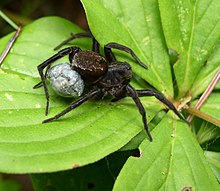Voles
| Voles | ||||||||||||
|---|---|---|---|---|---|---|---|---|---|---|---|---|

Arctosa cinerea ( Arctosa cinerea ), female |
||||||||||||
| Systematics | ||||||||||||
|
||||||||||||
| Scientific name | ||||||||||||
| Arctosa | ||||||||||||
| CL Koch , 1847 |
The voles ( Arctosa ) form a numerically large genus within the family of the wolf spiders (Lycosidae), which belongs to the order of the spiders . Species of this genus exist almost worldwide.
features
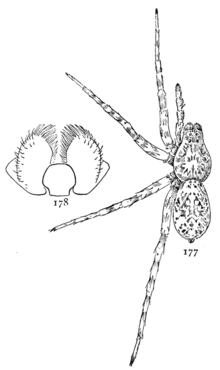
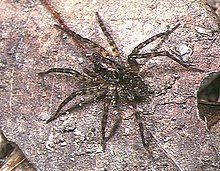
The voles are usually medium-sized to large wolf spiders with a body length of around 4.5 to 16 millimeters, depending on the species. Mostly they have a cryptic coloring that serves as camouflage. The sexual dimorphism (difference between the sexes) is rather weak in the species of this genus than in many other spiders.
From other members of this family, the Wühlwölfe distinguished particularly by a lack of other wolf spiders usually present median band and the V-shaped drawing on the carapace (carapace of Prosomas , and front body). In addition, the carapace of the voles is rather broad and flattened. Furthermore, the carapace has a uniform height between the anterior row of eyes and the fovea (apodem). The carapace of the voles is almost or completely bare. Depending on the type, its color ranges from yellow to cream-colored mottled or completely gray to brown. Another special feature of the genus is the position of the eyes: the anterior median eyes are larger than the anterior lateral eyes and the anterior row of eyes is straight or curved backwards. The back four eyes are arranged in a trapezoid shape, with the back eyes farther apart than the front ones. The chelicerae (jaw claws) in the species of voles each have a toothing on the inside, consisting of three or four teeth.
The legs of the voles are usually robust and usually appear pale. It is not uncommon for them to have dark ringlets or spots. The tibia (splints) of the third pair of legs are dorsally provided with two very small setae (hairs) or only with one and one basal bristle and then one to three retrolateral setae. The trochanters (thigh rings) usually have deep indentations on the ventral surface.
The opisthosoma (abdomen) of the voles is usually pale and spotty and thus resembles the prosoma in terms of its color.
Structure of the sexual organs

The bulbi (male sexual organs) in the voles have a rather conspicuous terminal apophysis ( chitinized process), which is divided into two parts or one part with two different shapes and degrees of sclerosis . The emboli (end members of the bulb) are straight or curved in shape, they are largely hidden by a median apophysis from the ventral side. This median apophysis is sclerotized (hardened with chitin), elongated and conspicuously grooved or hollowed out on the distal or dorsal surface. This makes it part of the functional leader. The emboli also have an extensive pars pendula that extends to the tip. The tegulum (penultimate part of the bulb) has a retrolateral protrusion that has a small and soft area and often a small, transparent, cup-shaped or prominent, sclerotized process that is also part of the conductor.
The epigyne (female sexual organ) is comparatively small and simple in structure in the species of the genus. It also usually has a conspicuous atrium divided by the central septum that has no dome. The copulation openings are located on the sides of the slender part of the median septum. The copulation tubes are slim to thick and tend to be short. They are often curved or twisted and sometimes have noticeable spermathe-like organs on the lateral edges. The spermathek (seed pocket) has a bulbous outline and no protrusions.
Genera with similar species
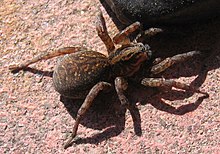
Due to their distinctive characteristics for wolf spiders, the voles are hardly to be confused with other representatives of this family. Sometimes similar species can be found in the genera Allocosa , the night wolves ( Trochosa ) and Varacosa . The types of Night Wolves, as the palearctic Erdwolfsspinne ( Trochosa terricola ), however, are built differently than the Wühlwölfe short legs and stocky. In addition, the aardwolf spider has dark lines on the carapace, whereas that of the voles is mostly without drawing. The aardwolf spider also inhabits the edges of forests, unlike most voles.
Some representatives of the genus Varacosa , such as the species V. gosiuta , which is represented in southern California , are somewhat more similar to the voles, for example V. gosiuta has a yellowish basic color and a carapace without markings . The species A. subparva , which belongs to the genus Allocosa and is distributed from southern California to northern Oregon , shows significantly more similarities to the voles . It has a dark and shiny carapace and an opisthosoma speckled with gray-brown and yellow tones.
Occurrence
With the exception of the polar regions, the voles are distributed worldwide. The majority of the species are found in the Old World , especially in Africa and Asia , although hardly any species occur in Southeast Asia . There are 18 species of voles in Europe. Many species of the genus are also common in Central and South America . In contrast, the voles are represented with comparatively few species in North America .
Species in German-speaking countries
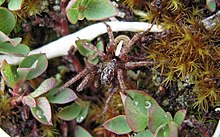
Of the European species, 11 are represented in Germany , Austria and the German-speaking area of Switzerland , although there are more species in the more southern parts of this country. The species occurring in the German-speaking area of all three countries mentioned above are as follows:
- Alpenwühlwolf ( A. alpigena ) and the subspecies Hochmoorwühlwolf ( A. a. Lamperti )
- Common wolf spider ( A. cinerea )
- Great steppe voles ( A. figurata )
- Leopard Wühlwolf ( A. leopardus )
- Little steppe wolf ( A. lutetiana )
- Spotted volesus ( A. maculata )
- Arctosa personata
- Colorful sandwolf ( A. perita )
- Arctosa renidescens
- Stocky Wühlwolf ( A. stigmosa )
- Arctosa variana
Habitats

The voles predominantly inhabit sandy and moist habitats, more rarely also moors. The demands on habitats can be different for the different species, which has led to the threat of individual populations in some species due to their attachment to certain wetlands after their biotopes have been drained or regulated (see section " Threat and Protection ").
The river wolf spider ( A. cinerea ), for example, only inhabits stony and gravel river banks, the spotted volesus ( A. maculata ) both gravelly and sandy ones . The variegated sandwolf is also found in sandy habitats far away from water, although it also prefers to be close to them. The alpine wolf ( A. alpigena ) z. B. lives in contrast to the three previously mentioned species in grass heaths, preferably in those in the central Alps.
Threat and protection

Due to the fact that some species are tied to their habitats as well as their highly fragmented distribution areas, they are exposed to not inconsiderable risks. This is particularly true of the species that inhabit sandy and / or gravelly river banks, as these habitats are particularly declining. The affected are spotted Wühlwolf ( A. maculata ) and especially the riverbank wolf spider ( A. cinerea ) and the ethnic Wühlwolf ( A. stigmosa ). Both of the latter species are listed in the Red List of Threatened Species of Animals, Plants and Fungi in Germany in Category 2 ("Endangered"), while the Spotted Wühlwolf is in Category 3 ("Endangered").
With the alpine burrowing wolf ( A. alpigena ) including the subspecies upland moor wolf ( A. a. Lamperti ) and the great steppe wolf ( A. figurata ), representatives of the genus that prefer special habitats away from water are also threatened. The Alpine Wühlwolf is listed in the Red List of Endangered Species of Animals, Plants and Fungi in Germany in the category R ("extremely rare"), since no precise analyzes exist on this rare species. The high moor grinder is listed in category 2, while the great steppe grinder is included in category 3.
Species that are less closely related to specific habitats and also have a larger range are less threatened. These include the small steppe voles ( A. lutetiana ), the leopard voles ( A. leopardus ) and the colorful sand voles ( A. perita ). While the colorful sand wolf is listed in the Red List of Endangered Species of Animals, Plants and Fungi in Germany in the pre-warning list ("V"), the small steppe wolf and the leopard wolf are classified as "safe".
Way of life

The species of the voles, like other larger wolf spiders, belong to the representatives of the family who dig living tubes and line them with webs . Exceptions are, for example, the leopard wolf ( A. leopardus ) and the spotted wolf ( A. maculata ). The majority of the species are predominantly nocturnal.
Hunting behavior and catch of prey
The species of the voles, like almost all spiders, are predatory and, like the majority of the wolf spiders, hunt without a safety net and therefore free-range. The well-developed eyes of the spiders are used to precisely locate the prey. As soon as they come within range of the hunter, they are jumped at by the hunter and then overwhelmed by the chelicerae with a poisonous bite .
Arthropods that do not exceed the dimensions of the spiders fall into the prey pattern of the voles .
Life cycle
The life cycle of the voles is divided into several stages and, in the case of the species that are widespread in the temperate climate zones, mostly depends on the seasons.
Phenology
The species of voles widespread in the temperate climate zones have seasonal fluctuations in activity times . The occurrence of both the young and of the adult specimens varies depending on the species within a year and is occasionally also different between the two sexes. The adult spiders of the genus are mainly active in the warm season.
Courtship and mating
The reproductive behavior of the voles corresponds to that of other wolf spiders. The males of the voles also use their own pheromones (messenger substances) to seek out the females' hiding places and perform a courtship dance that is characteristic of wolf spiders .
If the female signals willingness to mate, the male introduces his bulbs alternately into the epigyne of his sexual partner, as is usual for spiders. The duration of the pairing can vary depending on the species.
The young animals lay eggs and grow up

Some time after mating, the female makes an egg cocoon , which, like other wolf spiders , is attached to the spinnerets , but unlike other representatives of this family, it is hardly carried around, but is almost exclusively guarded in the shelter.
After hatching, the young climb onto their mother's opisthosoma and let them carry them for some time before they separate from their mother and grow up on their own. The juveniles of the species that are found in the temperate climatic zones overwinter in their hiding places and reach sexual maturity in the following year.
Systematics
The genus of the voles was first described by Carl Ludwig Koch in 1847 and, as of June 2020, comprises 169 validly described species including subspecies . The type species of the genus is the river wolf spider ( A. cinerea ).
Quite a few species of the genus previously belonged to other genera and were later transferred to the voles. 17 species of voles were also separated out and placed in other genera from the family of wolf spiders. A total of 30 species were synonymous with others and thus lost their own species status.
Not recognized species
Three species of the genus and a subspecies of the river wolf spider ( A. cinerea ) are now considered to be the nomina dubia . These are the following:
- Arctosa cinerea obscura ( Franganillo , 1913 )
- Arctosa misella ( L. Koch , 1882 )
- Arctosa picturella ( beach , 1906 )
- Arctosa schweinfurthi ( Strand , 1906 )
Synonymized genera
The following nine species of wolf spiders have also been synonymous with the voles. These are:
- Alopecosella , ( Roewer , 1960) , 2012 synonymized by Bosmans & Van Keer
- Arctosella , ( Roewer , 1960) , synonymized by Lugetti & Tongiorgi in 1966 & Guy in 1965
- Arkalosula , ( Roewer , 1960) 1983 synonymized by Dondale & Redner
- Bonacosa , ( Roewer , 1960) 1984 synonymized by Wunderlich
- Leaena , ( Simon , 1885) 1965 synonymized by Lugetti & Tongiorgi
- Leaenella , ( Roewer , 1960) 1984 synonymized by Wunderlich
- Tetrarctosa , ( Roewer , 1960) 1963 synonymized by Lugetti & Tongiorgi
- Tricca , ( Simon , 1889) 1963 synonymized by Dondale & Redner
- Triccosta , ( Roewer , 1960) 1963 synonymous with Braun
Individual evidence
- ↑ a b c d e f g C. D. Dondale & JH Speakers: REVISIONOF THE WOLFSPIDERSOF THEGENUSARCTOSA CL KOCH IN NORTH AND CENTRAL AMERICA (ARANEAE: LYCOSIDAE) , Journal of Arachnology, Volume 11, pp. 1–30, accessed June 29, 2020 .
- ↑ a b c d e f Arctosa (CL Koch, 1847) at the Wiki der Arachnologische Gesellschaft e. V., accessed on June 29, 2020.
- ↑ a b c L. Bee, G. Oxford, H. Smith: Britain's Spiders: A Field Guide , Princeton University Press, 2017, p. 221, ISBN 9780691165295 .
- ↑ a b c d e f Richard J. Adams: Field Guide to the Spiders of California and the Pacific Coast States , Volume 108 of California Natural History Guides, Univ of California Press, 2014, pp. 227-228, ISBN 9780520957046 .
- ↑ a b c d Arctosa (CL Koch, 1847) in the WSC World Spider Catalog , accessed June 29, 2020.
- ↑ Heiko Bellmann: Cosmos Atlas Arachnids of Europe . 3rd edition, 2006. Kosmos, Stuttgart., P. 190, ISBN 978-3-440-10746-1 .
- ↑ a b c Araneae (Clerck, 1757) at the Red List Center, accessed on June 29, 2020.
literature
- CD Dondale & JH Speakers: REVISIONOF THE WOLFSPIDERSOF THEGENUSARCTOSA CL KOCH IN NORTH AND CENTRAL AMERICA (ARANEAE: LYCOSIDAE) , Journal of Arachnology, Volume 11, pp. 1-30.
- L. Bee, G. Oxford, H. Smith: Britain's Spiders: A Field Guide , Princeton University Press, 2017, ISBN 9780691165295 .
- Richard J. Adams: Field Guide to the Spiders of California and the Pacific Coast States , Volume 108 of California Natural History Guides, Univ of California Press, 2014, ISBN 9780520957046 .
- Heiko Bellmann: Cosmos Atlas Arachnids of Europe . 3rd edition, 2006. Kosmos, Stuttgart., P. 190, ISBN 978-3-440-10746-1 .
Web links
- Arctosa in the World Spider Catalog
- Arctosa (CL Koch, 1847) at the Global Biodiversity Information Facility
- Arctosa (CL Koch, 1847) at Fauna Europaea
- Lycosidae (Sundevall, 1833) from The Spiders of Europe and Greenland
- Araneae (Clerck, 1757) at the Red List Center


